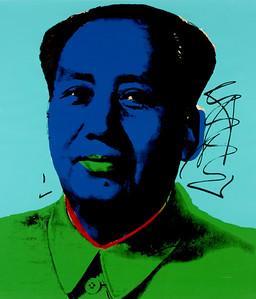Learn why Robert Clark renamed himself after his home state and Andy Warhol took so many photographs in the exhibition \"Love and Fame: Works by Robert Indiana and Andy Warhol from Indiana State University\'s Permanent Art Collection.\"
On display from Sept. 24 through Oct. 26 in the University Gallery, the exhibition consists of 10 large screenprints by Robert Indiana from his 1971 \"Decade\" portfolio and 80 color Polaroid portraits (studies for paintings) and black and white photographs of famous people and friends by Andy Warhol.
In 2007, Indiana State was one of 184 university galleries or museums to receive more than 150 Warhol photographs from the Warhol Foundation\'s Andy Warhol Photographic Legacy Program. The exhibition also includes two iconic Warhol prints, Flowers (1965) and Chairman Mao (1972). The exhibition reception, Monday, Sept. 24, from 4 to 6 pm, is free and open to the public.
Why Love and Fame? In 1964, Indiana created his iconic \"LOVE\" image for a Museum of Modern Art Christmas card. Four years later Andy Warhol famously said \"In the future, everyone will be world famous for 15 minutes.\" By the early 1970s the LOVE image was everywhere - as sculpture, paintings, prints, jewelry, clothing, and a postage stamp. It is now considered the most plagiarized American work of art. Warhol\'s quote was, and still is, often repeated, and anyone who was anyone began flocking to him for a portrait by the late 1960s.
Works in the exhibition span the years 1965 to 1986, one year before Warhol\'s death. Warhol\'s photographs allow viewers to embody his vision, especially considering that cameras accompanied him everywhere and became an extension of his eye and persona. Visitors may be surprised to learn that Indiana\'s Decade screenprints are not superficial Pop Art signs but rather self-portraits that chronicle memories and events of his upbringing in Indiana.
Among the highlights of the exhibition are: Warhol Polaroids of Truman Capote, Dracula, Maria Shriver, and Carly Simon; Indiana\'s screenprints \"Black and White Love\" and \"Terre Haute No. 2;\" and early photographs of Warhol and Indiana by William John Kennedy. The exhibition includes vintage album covers featuring Warhol paintings and Warhol\'s favorite camera, a 1971 Polaroid Big Shot.
Two scholars will present original research about the artists during the exhibition. On Sept. 25 Susan Elizabeth Ryan, associate professor of art history at Louisiana State University, will present \"Robert Indiana: Decade 1960s.\" On Oct. 11 William Ganis, associate professor of art history at Wells College, will present \"Photography: Andy Warhol\'s Social Disease.\" Both lectures begin at 5:30 p.m. in the Recital Hall across from the Gallery.
An exhibition catalog with essays by Ryan and Ganis will be available free to visitors. The exhibition and lectures are free and open to the public.
The University Art Gallery is located in the Richard G. Landini Center for Performing and Fine Arts at 300 N. Seventh Street. Gallery hours are Monday through Friday 11 a.m. to 4 p.m., Thursday 11 a.m. to 7 p.m. and, for Art Day, Saturday Oct. 13, from 9 a.m. to 5 p.m. For free group or school tours contact Jason Saavedra at 812-237-3720.
About the artists:
Born Robert Clark in New Castle, Robert Indiana lived in Indianapolis and graduated from Arsenal Technical High School. In 1953, he received a degree from the School of the Art Institute of Chicago and in 1954 he attended the Edinburgh College of Art in Scotland. In 1956, he moved to New York, where he became a part of the Pop Art movement. He began to paint in a geometric, hardedge style, blending commercial art and existentialism. While in New York, Indiana worked with Andy Warhol, creating \"Eat,\" a 45-minute film of Indiana eating a mushroom in his SoHo loft. He has lived in Maine since 1978.
Born in Pittsburgh, Warhol graduated in 1949 from the Carnegie Institute of Technology (now Carnegie Mellon University) with a bachelor of fine arts degree in pictorial design and moved to New York City to pursue a career as a commercial artist. Throughout the 1950s, he became one of the most successful illustrators of his time. Much of his commercial work was based on photographs and other source images, a process he would use for the rest of his life.
In the late 1950s he began to devote more energy to painting. He made his first Pop paintings, based on comics and ads, in 1961, and then a series of Campbell\'s soup cans in 1962. These created a sensation in the art world and launched Warhol as a celebrity. Except for a brief period in the mid-1960s, he would continue to paint until the end of his life. He also extended his talents into other fields such as film, publishing, writing, television, and music. By the time of his death in 1987, he was one of the most prolific and well-known artists the world had ever seen.
Writer: Paula Meyer, ISU Communications and Marketing, 812-237-3783 or paula.meyer@indstate.edu
